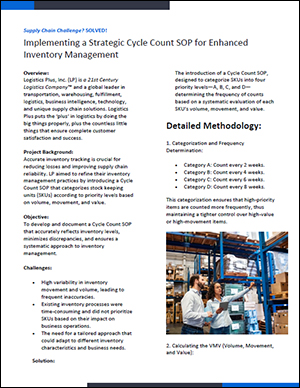Implementing a Cycle Count SOP
A Logistics Plus® Supply Chain Success Story!Implementing a Strategic Cycle Count SOP for Enhanced Inventory Management
Project Background:
Accurate inventory tracking is crucial for reducing losses and improving supply chain reliability. LP aimed to refine their inventory management practices by introducing a Cycle Count SOP that categorizes stock keeping units (SKUs) according to priority levels based on volume, movement, and value.
Objective:
To develop and document a Cycle Count SOP that accurately reflects inventory levels, minimizes discrepancies, and ensures a systematic approach to inventory management.
Challenges:
- High variability in inventory movement and volume, leading to frequent inaccuracies.
- Existing inventory processes were time-consuming and did not prioritize SKUs based on their impact on business operations.
- The need for a tailored approach that could adapt to different inventory characteristics and business needs.
Solution:
The introduction of a Cycle Count SOP, designed to categorize SKUs into four priority levels—A, B, C, and D—determining the frequency of counts based on a systematic evaluation of each SKU’s volume, movement, and value.
Detailed Methodology:
- Categorization and Frequency Determination:
- Category A: Count every 2 weeks.
- Category B: Count every 4 weeks.
- Category C: Count every 6 weeks.
- Category D: Count every 8 weeks.
This categorization ensures that high-priority items are counted more frequently, thus maintaining a tighter control over high-value or high-movement items.
2. Calculating the VMV (Volume, Movement, and Value):
- Volume: Measures the quantity of goods moved, reflecting stock levels.
- Movement: Tracks how frequently items are moved, indicating demand and turnover.
- Value: Assesses the financial impact of the goods.
These metrics are computed using data pulled from the Transaction History (Free Store) Report via CargoWise, ensuring that each SKU’s importance is quantified and assessed accurately.
- Categorization by Inter-quartile Range:
- The inter-quartile range for each VMV factor is calculated to identify the highest 25% of SKUs, scored as 1, the next 25% as 2, and so forth. This statistical approach allows for a nuanced categorization based on actual data, reducing subjectivity.
- Weighing and Scoring:
- Clients assign weights to the three factors based on their strategic importance. Each scored factor is then multiplied by its assigned weight, and an average score is calculated for each SKU. This weighted scoring system prioritizes SKUs based on their business impact.
Results:
The implementation of the Cycle Count SOP has led to a more accurate and efficient inventory management system. By systematically categorizing SKUs and adjusting the frequency of counts, the company has significantly reduced discrepancies and optimized the labor associated with inventory counts.
Impact:
- Reduction in inventory discrepancies by up to 30% within the first quarter post-implementation.
- Improved efficiency in warehouse operations, with a noticeable decrease in the time spent on inventory counts.
- Enhanced decision-making capabilities with more accurate, data-driven insights into inventory dynamics.
Conclusion:
The Cycle Count SOP has transformed the company’s approach to inventory management, introducing a level of precision and strategic focus that aligns inventory counts with business priorities. This case study highlights the benefits of integrating analytical tools and strategic planning into operational procedures to achieve operational excellence and business objectives.


